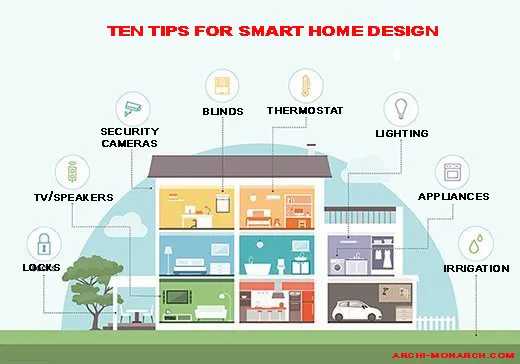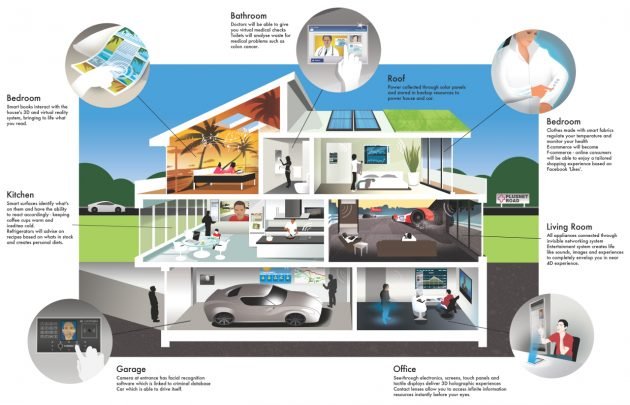
Are you ready to turn your home into a futuristic, intelligent oasis? Look no further! In this article, you’ll discover the top 10 steps to kickstart your journey towards building a smart home. From choosing the right hub to creating a connected ecosystem of devices, we’ll guide you through each essential step so you can experience the convenience and efficiency of a smart home in no time. So grab your smartphone and get ready to transform your living space into a realm of cutting-edge technology!

This image is property of archi-monarch.com.
1. Research and Plan
Know the Basics
Before diving into the world of smart homes, it’s important to have a basic understanding of what they are and how they work. A smart home is a house that uses internet-connected devices to enhance its functionality and automation. These devices can be controlled remotely through a smartphone or a voice assistant, making your life more convenient and efficient. Familiarize yourself with the concept of smart homes, the technology involved, and the benefits they offer.
Set Goals and Prioritize
Next, take some time to set goals for your smart home project. What do you want to achieve with your smart home? Determine the specific areas or functionalities you want to focus on, such as security, lighting, energy efficiency, or entertainment. By setting clear goals, you can prioritize your investments and make informed decisions when selecting smart devices.
Determine Compatibility
Compatibility is a crucial aspect to consider when building a smart home. Not all smart devices work seamlessly together, so it’s essential to ensure that the devices you choose are compatible with each other. Look for devices that support common protocols such as Wi-Fi, Z-Wave, or Zigbee, as these protocols enable devices from different manufacturers to communicate with each other. Check compatibility information provided by manufacturers and consider using a smart hub to centralize control and enhance compatibility.
2. Assess Your Infrastructure
Evaluate Network Connectivity
A stable and reliable network connection is essential for a smooth smart home experience. Assess the strength and coverage of your Wi-Fi network throughout your home. If you have dead zones or weak spots, consider adding Wi-Fi range extenders or mesh Wi-Fi systems to improve coverage. This will ensure that all your smart devices can communicate effectively and minimize connectivity issues.
Check Power Supply
When planning your smart home, it’s crucial to consider the power supply for your devices. Some devices may require a direct power source, while others may need batteries or rely on power outlets. Map out the locations of outlets and determine if additional ones are needed. Additionally, consider investing in surge protectors to protect your devices from power surges and ensure their longevity.
Consider Security Measures
As you invite more connected devices into your home, it becomes increasingly important to prioritize security. Research security measures and protocols that are implemented in smart devices and choose devices with robust security features. Consider investing in devices that support encryption, two-factor authentication, and regular firmware updates. This will help safeguard your smart home and protect it from potential cyber threats.
3. Choose a Smart Hub
Understand the Purpose of a Smart Hub
A smart hub acts as the central command center for your smart home, allowing you to control and manage multiple devices from a single interface. It simplifies your user experience by integrating different devices and protocols into one cohesive system. With a smart hub, you can control your lights, thermostats, security cameras, and more through a single app or even using voice commands.
Evaluate Different Hub Options
When choosing a smart hub, consider factors such as compatibility, features, and ease of use. Popular smart hub options include Amazon Echo (Alexa), Google Home (Google Assistant), and Apple HomePod (Siri). Assess the capabilities of each hub and determine which one aligns best with your goals and preferences. Look for hubs that support a wide range of devices and have positive user reviews.
Consider Integration with Other Devices
Compatibility with your other smart devices is essential when selecting a smart hub. Ensure that the hub you choose can seamlessly integrate with all the devices you plan to incorporate into your smart home. This will enable you to control all your devices through a single app or hub interface, maximizing convenience and streamlining your smart home experience.
4. Select Smart Devices
Identify Your Needs and Preferences
Before selecting smart devices, identify your specific needs and preferences. Assess which aspects of your home you want to automate or enhance. Do you want to control your lights, thermostat, or security system? Are you looking for smart appliances or entertainment options? Understanding your needs will help you make informed decisions when choosing smart devices.
Explore Various Categories of Smart Devices
There is a wide variety of smart devices available for different aspects of your home. Some popular categories include smart thermostats, smart lighting, smart locks, smart plugs, smart speakers, and smart security systems. Research and explore each category to understand the benefits and features of different devices. This will help you narrow down your options and select the devices that align with your goals.
Research and Compare Brands and Models
Once you’ve identified the categories of devices you want to incorporate into your smart home, spend some time researching different brands and models. Compare features, functionality, and user reviews to ensure you select devices that are reliable and suited to your needs. Look for established brands with a good reputation for quality and customer support.

This image is property of greenerideal.com.
5. Set Up a Smart Home Network
Configure Your Router
To create a stable and secure smart home network, start by configuring your router. Change the default username and password to enhance security and prevent unauthorized access. Familiarize yourself with your router’s settings and options, such as port forwarding and Quality of Service (QoS). Optimizing your router’s settings can improve the performance and reliability of your smart home network.
Establish a Stable Wi-Fi Connection
Wi-Fi is the backbone of your smart home, so it’s crucial that you have a stable connection throughout your home. Position your router in a central location to maximize coverage, and consider using Wi-Fi range extenders or a mesh Wi-Fi system for larger homes. Set up a dedicated SSID for your smart devices to ensure they operate on a separate network and minimize interference with other wireless devices.
Create a Separate Guest Network
To enhance security and protect your primary home network, create a separate guest network for visitors. Guest networks allow your guests to connect to the internet without accessing your smart home devices or personal data. This separation ensures that your smart home stays secure while still providing internet access to your visitors.
6. Install and Connect Devices
Follow Manufacturer’s Instructions
When installing smart devices, it’s important to carefully read and follow the manufacturer’s instructions. Each device may have specific installation requirements or nuances, so following the instructions will ensure proper setup. Take your time during installation and refer to troubleshooting guides or customer support if you encounter any issues.
Connect Devices to the Smart Hub
If you have chosen a smart hub as your central control system, connect your smart devices to the hub as per the manufacturer’s instructions. This process typically involves adding devices through the hub’s app or interface. Once connected, you can control and manage your devices through the hub’s app or voice commands.
Test Functionality and Troubleshoot
After installing and connecting your smart devices, it’s essential to test their functionality. Confirm that each device responds correctly to commands and performs as expected. If you encounter any issues, consult troubleshooting guides or contact customer support for assistance. It’s better to address any issues early on to ensure a smooth and consistent smart home experience.

This image is property of www.architectureartdesigns.com.
7. Secure Your Smart Home
Change Default Passwords
One of the simplest and most effective ways to protect your smart home is to change the default usernames and passwords of your smart devices. Default passwords are often widely known or easily deciphered, making your devices vulnerable to unauthorized access. Choose strong, unique passwords for each device and update them regularly to enhance security.
Update Firmware Regularly
Manufacturers release firmware updates periodically to address security vulnerabilities and improve device performance. Keep your smart devices up to date by regularly checking for firmware updates and installing them promptly. Often, devices can be set to update automatically, ensuring that you always have the latest security patches and features.
Enable Two-Factor Authentication
Two-factor authentication adds an extra layer of security to your smart home devices. By enabling two-factor authentication, you will be required to provide a second form of verification, such as a unique code sent to your smartphone, when logging into your smart home accounts. This minimizes the risk of unauthorized access even if your passwords are compromised.
8. Customize Automation Settings
Explore Automation Possibilities
One of the key advantages of a smart home is automation. Take advantage of automation by exploring the possibilities for your smart devices. Consider automating lights to turn on or off based on motion sensors, setting schedules for your thermostat, or integrating cameras with security systems. Automation allows you to create personalized and convenient experiences tailored to your lifestyle.
Create Customized Scenes
Scenes allow you to execute multiple commands or actions with a single command or trigger. For example, you could create a “Goodnight” scene that turns off lights, adjusts the thermostat, and activates security systems. Customize scenes based on your daily routines or specific scenarios to simplify control and create a more cohesive smart home experience.
Integrate Voice Control
Integrating voice control into your smart home provides a hands-free and effortless way to interact with your devices. If your chosen smart hub supports voice assistants like Alexa, Google Assistant, or Siri, set up voice control for your devices. This will allow you to control your smart home simply by using voice commands, making your daily routines even more convenient.

This image is property of smarthomesschool.com.
9. Download and Configure Apps
Download Associated Apps for Devices
Most smart devices have dedicated apps that allow you to control and manage them. Download the associated apps for your devices from the app store or manufacturer’s website. These apps will provide you with additional features, settings, and customization options for your smart devices.
Set Up User Accounts and Preferences
To personalize your smart home experience, set up user accounts within the apps. This will allow you to customize individual preferences and settings for each family member or user. Explore the available options and configure the apps according to your preferences, such as naming devices, creating schedules, or adjusting device settings.
Enable Remote Access
Enabling remote access to your smart home allows you to control and monitor your devices even when you’re away from home. Check if the associated apps support remote access and follow the instructions to enable this feature. Remote access provides peace of mind and flexibility, allowing you to manage your smart home from anywhere with an internet connection.
10. Expand and Upgrade
Experiment with New Devices
Once you have successfully built your smart home, continue to explore and experiment with new devices. Technology is constantly evolving, and new smart devices with innovative features are regularly introduced to the market. Stay updated with the latest trends, conduct research, and consider adding new devices that align with your goals and preferences.
Consider Home Security and Monitoring
Home security and monitoring are crucial aspects of a smart home. Consider investing in smart security systems, such as cameras, door/window sensors, and motion detectors, to enhance the safety of your home. Explore options for professional monitoring or self-monitoring through smartphone apps. Integrating security and monitoring systems provides peace of mind and allows you to proactively protect your home.
Stay Updated with Smart Home Trends
As the field of smart home technology advances, it’s important to stay informed about the latest trends and developments. Subscribe to technology blogs, forums, or newsletters that focus on smart homes. This will help you stay updated with new products, features, and best practices. Staying informed allows you to make informed decisions when expanding or upgrading your smart home.

This image is property of i.ytimg.com.



